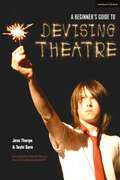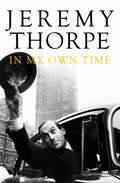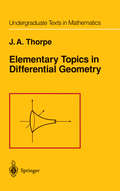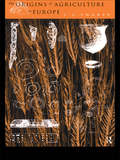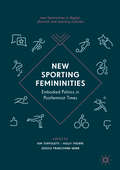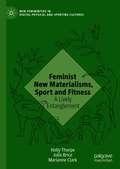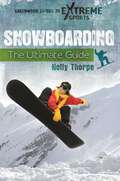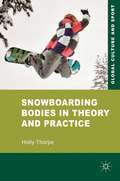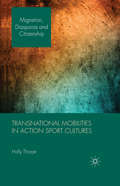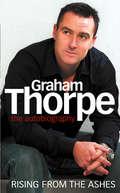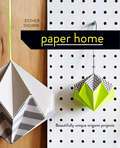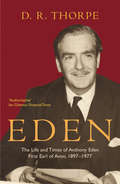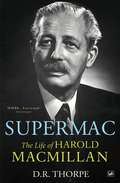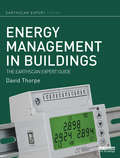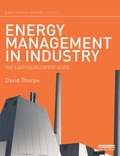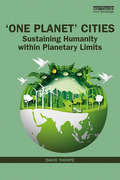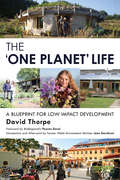- Table View
- List View
A Beginner's Guide to Devising Theatre
by Jess Thorpe Tashi GoreMuch of the theatre we make starts with a script and a story given to us by someone else. But what happens when we're required to start from scratch? How do we begin to make theatre using our own ideas, our own perspective, our own stories? A Beginner's Guide to Devising Theatre, written by the artistic directors of the award-winning young people's performance company Junction 25 and is aimed at those new to devising or wanting to further develop their skills. It explores creative ways to create original theatre from a contemporary stimulus. It offers a structure within which to approach the creative process, including ideas on finding a starting point, generating material, composition and design; it offers practical ideas for use in rehearsal; and it presents grounding in terminology that will support a confident and informed approach to production. The book features contributions from some of the young performers who have been a part of Junction 25's work to date, as well as key artists and companies that work professionally in devised theatre, including case studies from Quarantine, the Team, Mammalian Diving Reflex, Nic Green and Ontroerend Goed. The work of Junction 25 is used to illustrate the concepts and ideas set out in the book.Ideal for any student faced with the challenge of creating work from scratch, A Beginner's Guide to Devising Theatre offers constructive guidance, which supports the requirements of students taking Drama and Theatre Studies courses. The book includes a foreword by theatre critic Lyn Gardner.
A Beginner's Guide to Devising Theatre
by Jess Thorpe Tashi GoreMuch of the theatre we make starts with a script and a story given to us by someone else. But what happens when we're required to start from scratch? How do we begin to make theatre using our own ideas, our own perspective, our own stories? A Beginner's Guide to Devising Theatre, written by the artistic directors of the award-winning young people's performance company Junction 25 and is aimed at those new to devising or wanting to further develop their skills. It explores creative ways to create original theatre from a contemporary stimulus. It offers a structure within which to approach the creative process, including ideas on finding a starting point, generating material, composition and design; it offers practical ideas for use in rehearsal; and it presents grounding in terminology that will support a confident and informed approach to production. The book features contributions from some of the young performers who have been a part of Junction 25's work to date, as well as key artists and companies that work professionally in devised theatre, including case studies from Quarantine, the Team, Mammalian Diving Reflex, Nic Green and Ontroerend Goed. The work of Junction 25 is used to illustrate the concepts and ideas set out in the book.Ideal for any student faced with the challenge of creating work from scratch, A Beginner's Guide to Devising Theatre offers constructive guidance, which supports the requirements of students taking Drama and Theatre Studies courses. The book includes a foreword by theatre critic Lyn Gardner.
In My Own Time: Reminiscences Of A Liberal Leader
by Jeremy ThorpeOne of the most charismatic politicians of his age, Jeremy Thorpe recalls important events and episodes from his life in politics in this fascinating collection of anecdotes and reminiscences. In it he speaks candidly about important national events in his personal life and political career. For the first time Jeremy Thorpe speaks of his trial and acquittal in 1979. He puts on record his account of the coalition talks with Edward Heath in 1974 and describes the debilitating effects of Parkinson's Disease, from which he suffered until his death in 2014.
Elementary Topics in Differential Geometry (Undergraduate Texts in Mathematics)
by J. A. ThorpeIn the past decade there has been a significant change in the freshman/ sophomore mathematics curriculum as taught at many, if not most, of our colleges. This has been brought about by the introduction of linear algebra into the curriculum at the sophomore level. The advantages of using linear algebra both in the teaching of differential equations and in the teaching of multivariate calculus are by now widely recognized. Several textbooks adopting this point of view are now available and have been widely adopted. Students completing the sophomore year now have a fair preliminary under standing of spaces of many dimensions. It should be apparent that courses on the junior level should draw upon and reinforce the concepts and skills learned during the previous year. Unfortunately, in differential geometry at least, this is usually not the case. Textbooks directed to students at this level generally restrict attention to 2-dimensional surfaces in 3-space rather than to surfaces of arbitrary dimension. Although most of the recent books do use linear algebra, it is only the algebra of ~3. The student's preliminary understanding of higher dimensions is not cultivated.
The Origins of Agriculture in Europe (Material Cultures Ser.)
by I. J. ThorpeThe Origins of Agriculture in Europe takes a look at current ideas in the light of a considerable mass of literature and archaeological evidence; examining the transition to agriculture through the comparison of social and economic developments across Europe. In this volume, I.J.Thorpe manages to evaluate various alternative explanations in detailed examples, whilst also succeeding in addressing the broader theoretical questions which form the nucleus of contemporary debates. This clearly written and accessible text is an extremely valuable resource for students of European prehistory.
The Origins of Agriculture in Europe
by I. J. ThorpeThe Origins of Agriculture in Europe takes a look at current ideas in the light of a considerable mass of literature and archaeological evidence; examining the transition to agriculture through the comparison of social and economic developments across Europe. In this volume, I.J.Thorpe manages to evaluate various alternative explanations in detailed examples, whilst also succeeding in addressing the broader theoretical questions which form the nucleus of contemporary debates. This clearly written and accessible text is an extremely valuable resource for students of European prehistory.
New Sporting Femininities: Embodied Politics in Postfeminist Times (New Femininities in Digital, Physical and Sporting Cultures)
by Holly Thorpe Kim Toffoletti Jessica Francombe-WebbThis edited collection critically explores new and emerging models of female athleticism in an era characterised as postfeminist. It approaches postfeminism through a critical lens to investigate new forms of politics being practised by women in physical activity, sport and online spaces at the intersections of gender, ethnicity, sexuality and ability. New Sporting Femininities features chapters on celebrity athletes such as Serena Williams and Ronda Rousey, alongside studies of the online fitspo movement and women’s growing participation in activities like roller derby, skateboarding and football. In doing so, it highlights key issues and concerns facing diverse groups of women in a rapidly changing gender-sport landscape. This collection sheds new light on the complex and often contradictory ways that women’s athletic participation is promoted, experienced and embodied in the context of postfeminism, commodity feminism and emerging forms of popular feminism.
New Sporting Femininities: Embodied Politics in Postfeminist Times (New Femininities in Digital, Physical and Sporting Cultures)
by Holly Thorpe Kim Toffoletti Jessica Francombe-WebbThis edited collection critically explores new and emerging models of female athleticism in an era characterised as postfeminist. It approaches postfeminism through a critical lens to investigate new forms of politics being practised by women in physical activity, sport and online spaces at the intersections of gender, ethnicity, sexuality and ability. New Sporting Femininities features chapters on celebrity athletes such as Serena Williams and Ronda Rousey, alongside studies of the online fitspo movement and women’s growing participation in activities like roller derby, skateboarding and football. In doing so, it highlights key issues and concerns facing diverse groups of women in a rapidly changing gender-sport landscape. This collection sheds new light on the complex and often contradictory ways that women’s athletic participation is promoted, experienced and embodied in the context of postfeminism, commodity feminism and emerging forms of popular feminism.
Feminist New Materialisms, Sport and Fitness: A Lively Entanglement (New Femininities in Digital, Physical and Sporting Cultures)
by Holly Thorpe Julie Brice Marianne ClarkThis book offers the first critical examination of the contributions of feminist new materialist thought to the study of sport, fitness, and physical culture. Bringing feminist new materialist theory into a lively dialogue with sport studies, it highlights the possibilities and challenges of engaging with posthumanist and new materialist theories. With empirical examples and pedagogical offerings woven throughout, the book makes complex new materialist concepts and theories highly accessible. It vividly illustrates sporting matter as lively, vital, and agentic. Engaging specifically with the methodological, theoretical, ethical and political challenges of feminist new materialisms, it elaborates understandings of moving bodies and their entanglements with human, non-human, technological, biological, cultural, and environmental forces in contemporary society. This book extends humanist, representationalist, and discursive approaches that have characterized the landscape of critical research on active bodies, and invites new imaginings and articulations for sport and moving bodies in uncertain times and unknown futures.View the video abstracts for each of the book's chapter here: Chapter 1 https://www.youtube.com/watch?v=3UQy7aq1k20&list=PLdbxSLlj0ri04cOHxK37TfaQg0IAv6Znf&index=1 Chapter 2 https://www.youtube.com/watch?v=yM-Q4FmW6h8&list=PLdbxSLlj0ri04cOHxK37TfaQg0IAv6Znf&index=2 Chapter 3 https://www.youtube.com/watch?v=D0VxosyyrKg&list=PLdbxSLlj0ri04cOHxK37TfaQg0IAv6Znf&index=3 Chapter 4 https://www.youtube.com/watch?v=eN9b58fPISA&list=PLdbxSLlj0ri04cOHxK37TfaQg0IAv6Znf&index=4 Chapter 5 https://www.youtube.com/watch?v=GM3Ss_Tz0ZY&list=PLdbxSLlj0ri04cOHxK37TfaQg0IAv6Znf&index=5 Chapter 6 https://www.youtube.com/watch?v=pNbSBThlR6s&list=PLdbxSLlj0ri04cOHxK37TfaQg0IAv6Znf&index=6 Chapter 7 https://www.youtube.com/watch?v=NFRAGwH8UOY&list=PLdbxSLlj0ri04cOHxK37TfaQg0IAv6Znf&index=7
Snowboarding: The Ultimate Guide (Greenwood Guides to Extreme Sports)
by Holly ThorpeThis book provides a comprehensive look at the snowboarding phenomenon, including its history; techniques and equipment; biographies of the sport's pioneers, athletes, and heroes; key sites and events; and future directions.While snowboarding didn't become a commercial success until the early 1980s, the roots of the modern snowboard go back to at least 1964, when Sherman Poppen invented the "Snurfer" by bolting two skis together and adding a rope for stability. Today snowboarding is one of the most prominent and appealing youth sports. Want proof? Professional snowboarder and two-time Olympic gold medalist Shaun White was the highest paid athlete entering the 2010 Winter Olympics with an estimated annual salary of $10 million.The book is a highly accessible and extensive overview of snowboarding, providing an introduction to the sport and lifestyle of snowboarding; a historical timeline of the rapid growth of snowboarding; techniques and equipment used; and a discussion of key places and events, such as Alaska, Winter X Games, and the Winter Olympics.
Snowboarding: The Ultimate Guide (Greenwood Guides to Extreme Sports)
by Holly ThorpeThis book provides a comprehensive look at the snowboarding phenomenon, including its history; techniques and equipment; biographies of the sport's pioneers, athletes, and heroes; key sites and events; and future directions.While snowboarding didn't become a commercial success until the early 1980s, the roots of the modern snowboard go back to at least 1964, when Sherman Poppen invented the "Snurfer" by bolting two skis together and adding a rope for stability. Today snowboarding is one of the most prominent and appealing youth sports. Want proof? Professional snowboarder and two-time Olympic gold medalist Shaun White was the highest paid athlete entering the 2010 Winter Olympics with an estimated annual salary of $10 million.The book is a highly accessible and extensive overview of snowboarding, providing an introduction to the sport and lifestyle of snowboarding; a historical timeline of the rapid growth of snowboarding; techniques and equipment used; and a discussion of key places and events, such as Alaska, Winter X Games, and the Winter Olympics.
Snowboarding Bodies in Theory and Practice (Global Culture and Sport Series)
by H. ThorpeThis book provides the first in-depth analysis of the global phenomenon of snowboarding culture. Adopting an interdisciplinary approach, it offers key insights into the sport, lifestyle, industry, media, gender relations, travel, and physical experience of snowboarding, in both historical and contemporary contexts.
Transnational Mobilities in Action Sport Cultures (Migration, Diasporas and Citizenship)
by H. ThorpeThis book contributes to recent debates in transnationalism, mobilities and migration studies by offering the first in-depth sociological examination of the global phenomenon of action sports and the transnational networks and connections being established within and across local contexts around the world.
Graham Thorpe: Rising From The Ashes
by Graham ThorpeGraham Thorpe’s achievements on the cricket field contrasted wildly with his personal problems, where drink and depression combined to send him spiralling off the rails. This is his brutally honest life story, including his dramatic retirement from Test cricket, and updated to include England’s 2005 Ashes win, and his new coaching career.
Paper Home: Beautifully Unique Origami Projects
by Esther ThorpeWith a distinctly graphic aesthetic, Esther Thorpe’s first book contains step-by-step instructions for 15 stunning origami projects for the home.
Eden: The Life and Times of Anthony Eden First Earl of Avon, 1897-1977
by Dr D R ThorpeAnthony Eden, who served as both Foreign Secretary and Prime Minister, was one of the central political figures of the twentieth century. He had good looks, charm, a Military Cross from the Great War, an Oxford first and a secure parliamentary constituency from his mid-twenties. He was Foreign Secretary at the age of 38, and the first British statesman to meet Hitler, Mussolini and Stalin. Eden's dramatic resignation from Neville Chamberlain's Cabinet in 1938, outlined here in the fullest detail yet, made an international impact.This ground-breaking book examines his controversial life and tells the inside story of the Munich crisis (1938), the Geneva Conference (1954), Eden's battles with Churchill over the modernisation of the post-war Conservative Party and his rivalry with Butler and Macmillan in the early 1950s, culminating in a fascinating analysis of the Suez crisis.
Supermac: The Life of Harold Macmillan
by Dr D R ThorpeGreat-grandson of a crofter and son-in-law of a Duke, Harold Macmillan (1894-1986) was both complex as a person and influential as a politican. Marked by terrible experiences in the trenches in the First World War and by his work as an MP during the Depression, he was a Tory rebel - an outspoken backbencher, opposing the economic policies of the 1930s and the appeasement policies of his own government.Churchill gave him responsibility during the Second World War with executive command as 'Viceroy of the Mediterranean'. After the War, in opposition, Macmillan was one of the principal reformers of the Conservatives, and after 1951, back in government, served in several important posts before becoming Prime Minister after the Suez Crisis.Supermac examines key events including the controversy over the Cossacks repatriation, the Suez Crisis, You've Never Had It So Good, the Winds of Change, the Cuban Missile Crisis and the Profumo Scandal. The culmination of thirty-five years of research into this period by one of our most respected historians, this book gives an unforgettable portrait of a turbulent age.Shortlisted for the Orwell Prize.
Energy Management in Buildings: The Earthscan Expert Guide (Earthscan Expert)
by David ThorpeThe role of the energy manager has evolved significantly as the task of cutting greenhouse gas emissions from buildings has become increasingly important. Managers are now technical experts, negotiators, construction project managers, procurement specialists, efficiency advocates and often provide energy services to others. This comprehensive book covers how to: • conduct an energy audit • plan a monitoring and verification strategy • make any energy-saving campaign successful • evaluate and make the financial case for energy-saving measures • make use of free energy for lighting and managing heat loss and gain. It also contains special chapters on: • ventilation, heating and cooling • demand management through automated systems • lighting • most requirements of industrial facilities • regulatory requirements in Britain, Europe and the United States • the use of smart meters and monitoring • how to achieve zero energy buildings • the use of renewable energy. For all professional energy, building and facilities managers, energy consultants, students, trainees and academics. It takes the reader from basic concepts to the latest advanced thinking, with principles applicable anywhere in the world and in any climate.
Energy Management in Buildings: The Earthscan Expert Guide (Earthscan Expert)
by David ThorpeThe role of the energy manager has evolved significantly as the task of cutting greenhouse gas emissions from buildings has become increasingly important. Managers are now technical experts, negotiators, construction project managers, procurement specialists, efficiency advocates and often provide energy services to others. This comprehensive book covers how to: • conduct an energy audit • plan a monitoring and verification strategy • make any energy-saving campaign successful • evaluate and make the financial case for energy-saving measures • make use of free energy for lighting and managing heat loss and gain. It also contains special chapters on: • ventilation, heating and cooling • demand management through automated systems • lighting • most requirements of industrial facilities • regulatory requirements in Britain, Europe and the United States • the use of smart meters and monitoring • how to achieve zero energy buildings • the use of renewable energy. For all professional energy, building and facilities managers, energy consultants, students, trainees and academics. It takes the reader from basic concepts to the latest advanced thinking, with principles applicable anywhere in the world and in any climate.
Energy Management in Industry: The Earthscan Expert Guide (Earthscan Expert)
by David ThorpeEnergy demand reduction is fast becoming a business activity for all companies and organisations because it can increase profits regardless of the nature of their core activity. The International Energy Agency believes that industry could improve its energy efficiency and reduce carbon dioxide emissions by almost a third using the best available practices and technologies. This guide looks at the many ways available to energy managers to achieve or even exceed this level of performance, including: base-lining consumption planning a monitoring and verification strategy metering (including smart, wireless metering) energy supply management motors and drives compressed air and process controls. Uniquely, it includes a whole chapter on greening data centres. It also looks at topics covered in greater detail in its companion volume, Energy Management in Buildings: insulation, lighting, renewable heating, cooling and HVAC systems. Further chapters examine minimising water use and how to make the financial case, both to prioritise measures for cost effectiveness, and to get management on board. This title is aimed at all professional energy, industry and facilities managers, energy consultants, students, trainees and academics and can be read alongside training for ISO 50001 - Energy Management Systems. It takes the reader from basic concepts to the latest advanced thinking, with principles applicable anywhere in the world and in any climate.
Energy Management in Industry: The Earthscan Expert Guide (Earthscan Expert)
by David ThorpeEnergy demand reduction is fast becoming a business activity for all companies and organisations because it can increase profits regardless of the nature of their core activity. The International Energy Agency believes that industry could improve its energy efficiency and reduce carbon dioxide emissions by almost a third using the best available practices and technologies. This guide looks at the many ways available to energy managers to achieve or even exceed this level of performance, including: base-lining consumption planning a monitoring and verification strategy metering (including smart, wireless metering) energy supply management motors and drives compressed air and process controls. Uniquely, it includes a whole chapter on greening data centres. It also looks at topics covered in greater detail in its companion volume, Energy Management in Buildings: insulation, lighting, renewable heating, cooling and HVAC systems. Further chapters examine minimising water use and how to make the financial case, both to prioritise measures for cost effectiveness, and to get management on board. This title is aimed at all professional energy, industry and facilities managers, energy consultants, students, trainees and academics and can be read alongside training for ISO 50001 - Energy Management Systems. It takes the reader from basic concepts to the latest advanced thinking, with principles applicable anywhere in the world and in any climate.
'One Planet' Cities: Sustaining Humanity within Planetary Limits
by David ThorpeThis book addresses the crucial question of how the essential needs of the growing human population can be met without breaking the Earth's already-stretched life-support system. With four out of five people predicted to be urban dwellers by 2080, ‘One Planet’ Cities proposes a pathway to genuine sustainability for cities and neighbourhoods, using an approach based on contraction and convergence. Utilising interviews with key players, including the Global Footprint Network, World Future Council, WWF, mayors and government officials, and case studies from across the globe, including Europe, North and South America, Australia, South Africa, China and India, David Thorpe examines all aspects of modern society from food provision to neighbourhood design, via industry, the circular economy, energy and transport through the critical lens of the ecological footprint and relevant supporting international standards and indicators. Recommendations on managing supply chains and impacts, how the transition to a world within limits might be financed, and a deep examination of the Welsh Government's pioneering efforts follow. It concludes with an imagined vision of what a genuinely sustainable future might be like, and an appeal for 'one planeteers' everywhere to step up to the challenge. This book will be of great interest to practitioners and policymakers involved in governance, administration, urban environments and sustainability, alongside students of the built environment, urban planning, environmental policy and energy.
'One Planet' Cities: Sustaining Humanity within Planetary Limits
by David ThorpeThis book addresses the crucial question of how the essential needs of the growing human population can be met without breaking the Earth's already-stretched life-support system. With four out of five people predicted to be urban dwellers by 2080, ‘One Planet’ Cities proposes a pathway to genuine sustainability for cities and neighbourhoods, using an approach based on contraction and convergence. Utilising interviews with key players, including the Global Footprint Network, World Future Council, WWF, mayors and government officials, and case studies from across the globe, including Europe, North and South America, Australia, South Africa, China and India, David Thorpe examines all aspects of modern society from food provision to neighbourhood design, via industry, the circular economy, energy and transport through the critical lens of the ecological footprint and relevant supporting international standards and indicators. Recommendations on managing supply chains and impacts, how the transition to a world within limits might be financed, and a deep examination of the Welsh Government's pioneering efforts follow. It concludes with an imagined vision of what a genuinely sustainable future might be like, and an appeal for 'one planeteers' everywhere to step up to the challenge. This book will be of great interest to practitioners and policymakers involved in governance, administration, urban environments and sustainability, alongside students of the built environment, urban planning, environmental policy and energy.
The 'One Planet' Life: A Blueprint for Low Impact Development
by David ThorpeThe One Planet Life demonstrates a path for everyone towards a way of life in which we don’t act as if we had more than one planet Earth. The difference between this approach and others is that it uses ecological footprint analysis to help to determine how effective our efforts are. Much of the book is a manual – with examples – on how to live the 'good life' and supply over 65% of your livelihood from your land with mostly positive impacts upon the environment. It examines the pioneering Welsh policy, One Planet Development, then considers efforts towards one planet living in urban areas. After a foreword by BioRegional/One Planet Living co-founder Pooran Desai and an introduction by former Welsh environment minister Jane Davidson, the book contains: An essay arguing that our attitude to planning, land and development needs to change to enable truly sustainable development. Guidelines on finding land, finance, and creating a personal plan for one planet living. Detailed guides on: sustainable building, supplying your own food, generating renewable energy, reducing carbon emissions from travel, land management, water supply and waste treatment. 20 exemplary examples at all scales – from micro-businesses to suburbs – followed by Jane Davidson’s Afterword. The book will interest anyone seeking to find out how a sustainable lifestyle can be achieved. It is also key reading for rural and built environment practitioners and policy makers keen to support low impact initiatives, and for students studying aspects of planning, geography, governance, sustainability and renewable energy.
The 'One Planet' Life: A Blueprint for Low Impact Development
by David ThorpeThe One Planet Life demonstrates a path for everyone towards a way of life in which we don’t act as if we had more than one planet Earth. The difference between this approach and others is that it uses ecological footprint analysis to help to determine how effective our efforts are. Much of the book is a manual – with examples – on how to live the 'good life' and supply over 65% of your livelihood from your land with mostly positive impacts upon the environment. It examines the pioneering Welsh policy, One Planet Development, then considers efforts towards one planet living in urban areas. After a foreword by BioRegional/One Planet Living co-founder Pooran Desai and an introduction by former Welsh environment minister Jane Davidson, the book contains: An essay arguing that our attitude to planning, land and development needs to change to enable truly sustainable development. Guidelines on finding land, finance, and creating a personal plan for one planet living. Detailed guides on: sustainable building, supplying your own food, generating renewable energy, reducing carbon emissions from travel, land management, water supply and waste treatment. 20 exemplary examples at all scales – from micro-businesses to suburbs – followed by Jane Davidson’s Afterword. The book will interest anyone seeking to find out how a sustainable lifestyle can be achieved. It is also key reading for rural and built environment practitioners and policy makers keen to support low impact initiatives, and for students studying aspects of planning, geography, governance, sustainability and renewable energy.
